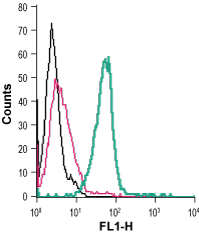Overview
- Peptide CFHYRDRHNAKGE, corresponding to amino acid residues 197-209 of mouse GPR34 (Accession Q9R1K6). 2nd extracellular loop.
The G-protein-coupled receptor 34 (GPR34) is currently classified as an orphan receptor of the P2Y12-like receptor group. The receptor belongs to the super family of G-protein coupled receptors (GPCRs)1.
The N-terminus of human GPR34 has three putative N-glycosylation sites (NXS/T), and the C-terminus has a cysteine residue which is palmitoylated in many GPCRs. GPR34 contains several putative phosphorylation sites primed by a serine or threonine in the C-terminus2.
GPR34 is highly expressed in immune cells such as mast cells, macrophages, microglia, and immune system–derived cell lines (HL-60, K562, WEHI-3B, RAW 264.7, P815). Studies show that GPR34 function is required to arrest microglia in the M0 homeostatic non-phagocytic phenotype and downregulation of GPR34 promotes the neurodegenerative microglia phenotype2,3,4.
GPR34 is linked to several human diseases including immunological diseases and cancer. Most known effects of GPR34 are immune function-related. For example, GPR34 is significantly down-regulated in Mycobacterium tuberculosis-infected macrophages; GPR34 mRNA is significantly lower in the cerebrospinal fluid from multiple sclerosis patients; GPR34 is significantly upregulated in the striatum and cortex of patients with Parkinson's disease but downregulated in substantia nigra. elevated GPR34 also plays a role in the progression of some tumors, such as human gastric adenocarcinoma, mucosa-associated lymphoid tissue (MALT) lymphoma, and colorectal cancer1-3.

